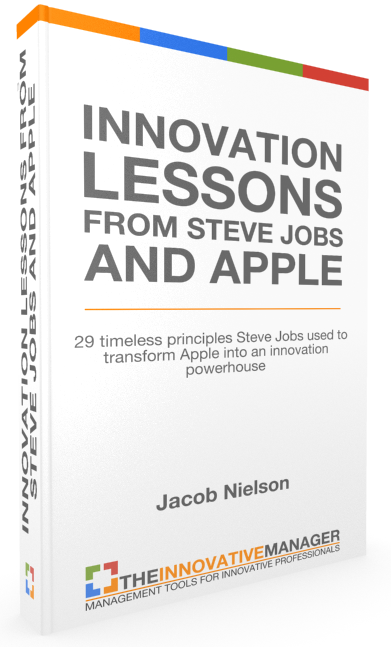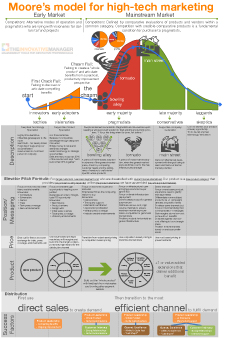This is post 3 of 5 on Game Theory examples and their application to innovation and management…enjoy! To access post 1 of 5 on locations, click here.
To follow along in Excel, download the Game Theory Bertrand template here.
To view my other posts on game theory, see the list below:

FREE VIDEO TRAINING FOR INNOVATORS
Over 100 Slides Free and Downloadable as a PDF
Game Theory Post 1: Game Theory Basics – Nash Equilibrium
Game Theory Post 2: Location Theory – Hotelling’s Game
Game Theory Post 4: JC Penny (Price Discrimination)
Game Theory Post 5: Mixed Strategies
Over the past several years the fate of Best Buy has been in question. Business pundits have long predicted their demise thanks to the triumph of the online juggernaut – Amazon. Part of the issue for Best Buy, pundits said, was something called “showrooming” where customers would stop in to Best Buy only to look at a product in person, check out how it looks and feels in it’s physical form, then purchase it online at Amazon. So basically Best Buy was Amazon’s brick and mortar “showroom.” Not a good situation for Best Buy to be in.
The issue usually came down to price. The prices of the same or similar electronics at Best Buy were typically higher than the prices available online at Amazon. A major reason for higher prices at Best Buy could be that their cost structure is saddled with brick and mortar stores all across the country and the sales staff required to support those stores. Given this scenario, what would you do if you were the CEO of Best Buy?
To figure this out, let’s suppose all you could do was change Best Buy’s pricing and then analyze the following scenarios from a game theory perspective:
- Hold Price – Status quo
- Best Price – Always offer the lowest price versus competitors
- Price Match – Always offer to match competitor’s prices even when they are lower than yours
Now lets start the analysis…
Pricing Strategy Option 1: Hold Prices
Let’s pretend that you are the CEO of Best Buy and you love your stores so much that you can’t get enough of them. You love walking inside, smelling the “new TV’s smell” and chatting it up with the Geek Squad. As you walk down the isles, you look at all the prices and think: “They are perfect! Consumers will love them AND we’ll make tons of money!” You can’t imagine a much better retail strategy than to just continue to advertise your great stores, products, services and prices so more people will know how awesome your stores are. You fully recognize that there are some places online, or on the “interwebs” as you like to refer to them, that offer the exact same products for slightly lower prices. Usually the price difference isn’t much – maybe 5-10% at very most. But you’re not worried because you know that shopping online doesn’t give consumers the chance to “touch and feel” the devices or a chance to talk with the geniuses that make up the Geek Squad – that haven of consumer advice in a sea of technological turmoil. Because of your belief in the company, you decide to hold prices steady – despite the risk of online retailers offering lower prices.
But then one day it hits you like a ton of bricks – bam! Sales are falling and your customers are saying in surveys that the reason they didn’t buy from you is because your prices are higher than what they could pay for the same products if they purchased them online.
Uh oh.
So far the payoff for holding to your current pricing strategy has been dismal. Your stock is falling and profitability is draining out of the company. Your faith in the in-store experience was not as well placed after all. Consumers are not convinced. Time to look at other options. As a savvy CEO, you realize that in some cases you were just flat wrong. You’re a humble CEO and want what’s best for your company so you decide to evaluate some alternatives to pricing, namely:
- Best Price Strategy – Always offer the lowest price versus competitors
- Price Match Strategy – Always offer to match competitor’s prices even when they are lower than yours
On the surface, neither of these ideas sound very appealing at all. But you’re not one to pass judgement without having done a detailed analysis. So let’s dive in!
Pricing Strategy Option 2: Best Price
For this scenario, put yourself in the shoes of the consumer as someone who wants to buy a 15″ flat screen TV.
Assume for a moment that the TV is sold at both retailers (it is the exact same TV) and costs $60 from the manufacturer for both Best Buy and Amazon.
| Amazon | Best Buy | |
| Marginal Cost of 15″ TV: | $60 | $60 |
Most pundits believe Amazon has lower overhead costs than Best Buy, but in this case we will only consider the marginal cost of the product and not overhead. The reason for this is more complicated than the scope of this article but the basic reason has to do with the fact that any product sold for a price higher than its marginal cost will contribute to paying for the fixed costs of the business. Said another way, a business will usually price their products higher than that product’s marginal cost and in some cases equal to the marginal cost. The difference between marginal and full cost from a retailers perspective are as follows:
Marginal cost is the additional cost to sell one more TV (in this case, the cost of the TV to the retailer)
Full cost = marginal cost + retail overhead costs
In short, this means that it costs Best Buy and Amazon $60 to purchase and sell one more TV to you. There would be no profit for Best Buy or Amazon if they sold the TV at a price of $60; it’s just enough to cover the costs to them of purchasing that one more TV.
Back to the story…when you go into Best Buy to look at this 15″ TV, they have it listed for $75 out the door – a price that would give them $15 in profit for every unit sold. You see the price and wonder what the price is on Amazon. So you use your Amazon price check app and find out that Amazon has the exact same TV listed for $74 delivered to your home. Instead of making the purchase from your phone, you decide to tell the Best Buy store manager and you inform him that you will buy the TV from the seller with the lowest price. He then lowers the price to $73 and beats Amazon’s price. You are excited but you’re also starting to feel pretty confident in your bargaining skills so you decide to call Amazon on the spot and ask them for a better price. To your amazement, they say they’ll drop the price to $72 and beat Best Buy to secure your business. You then inform the Best Buy manager that you’ll be purchasing the TV on Amazon for $72. But before you make that “1-click” purchase, the manager stops you and offers you the TV for $71.
This is starting to get out of hand. But the negotiations are going well for you, so you decide to continue pitting each seller’s price against each other. Let’s suppose that you continue to get both Best Buy and Amazon to drop their price all the way down to $60. Try as you might, you can’t seem to get either seller to go lower than $60. Here’s a summary of the negotiations so far:
This is a classic example of what Game Theorists call “Bertrand Price Competition,” named after Joseph Bertrand. Bertrand was a French mathematician in the late 1800’s who posited that if a market consisted of two sellers (in this case, Best Buy and Amazon) who sold the exact same products and where they shared the same location (because Amazon is available on smartphones, they are essentially available everywhere and in that sense share the same location as Best Buy) then the two sellers would compete with each other solely on price and that the seller with the lowest price would win. This cut-throat scenario is devastating to businesses because ultimately each seller is incentivized to lower prices until the price equals the marginal cost to produce (or in this case to sell at retail) the product. When that happens, there is no more profit for either business but enough revenue to at least cover costs. This is a great thing for consumers because it means that businesses reach the lowest feasible price – not just low prices but the lowest feasible price the retailer can sell it to you for.
To further illustrate this type of competition, let’s think of it in terms of a reaction function. As background, a reaction function is simply an equation that tells you how to respond to a competitor. Once we understand this equation, we can then plot it on a graph.
In this case, the reaction function was actually very simple for both Amazon and Best Buy. For each offer from Amazon, the Best Buy counter offer was always $1 less. As an equation, it looks something like this:
Best Buy Offer = Amazon Offer – $1
Amazon Offer = Best Buy Offer – $1
These two simple reaction functions can be illustrated as follows:
As we can see from the graph on the right, if the customer sees the first price from Best Buy at $75, then Amazon will set their price at $74. The price war continues until both sellers reach their price floor of the marginal cost for that item, which in this case is $60. That is the stable, or equilibrium, price of the TV under a “best price” pricing strategy.
So back to pretending if you were CEO of Best Buy (rather than pretending you were a customer wanting to buy a TV). After seeing where a “best price” strategy leads, you probably won’t want to go down that path. For many businesses it is a very dark and treacherous path but may be justified for large organizations who are seeking to maintain a foothold in a market by squeezing out a new and much smaller competitor. That’s not the case with Best Buy – Amazon is not very new and is definitely not small.
Let’s dive into the third pricing strategy…
Pricing Strategy Option 3: Price Matching
Going back to the example of the 15″ TV. Let’s rewind the story to the moment you first saw the TV in Best Buy and decided to pull out your smartphone and check the price of that TV on Amazon. When you noticed the price on Amazon was $74 instead of $75, you told the Best Buy store manager that you would purchase the TV from the seller with the lowest price. In the “best price” scenario, the Best Buy manager told you he would beat their price by $1 down to the point of reaching the store’s marginal cost. However, in this example the Best Buy manager’s response was quite different. Instead of beating the price, he told you he would match the price on Amazon.
Hmmm…interesting.
As a consumer, you actually feel pretty good about this offer. You know that you are getting a better deal than Best Buy originally intended to give you and you are excited because you can get the TV and take it home right now without having to wait for shipping. So what do you decide to do as a consumer? Make the purchase!
See what happened? Best Buy’s price match worked out well for Best Buy and was a bit of a mixed bag for the consumer. For example, if Best Buy had started a bidding war, the consumer would have been even happier. But with a price match, the consumer is still happy but doesn’t realize that the price match actually created a hard stop to the negotiations. They still got a good deal, but not quite as good of a deal if the retailers had been trying to undercut each other’s prices.
One other important thing to note is that the “Price Match” did not affect Amazon in any material way. That might sound counter-intuitive (like most of game theory), but the truth is that the price match actually helped to level the competitive playing field to favor the retailer who had first contact with the customer. For example, in our story the consumer buying a 15″ TV started their shopping by entering a Best Buy store. This gave Best Buy a slight advantage because they were initially favored by the customer. If, on the other hand, the consumer had first started their shopping on Amazon, then Amazon would have had the advantage – assuming a price match scenario.
Another way to think of how price matching helps businesses (and usually consumers, just not as much as Bertrand competition, or “Best Price” does) is that it equates all pricing among competitors and acts as a form of collusion. Though price matching is great for PR, the truth is that price matching is a way for retailers to reduce and in some cases, eliminate the pressure to lower prices.
Things are not always what they seem!
To summarize, below is a table of nine possible scenarios and the implications of each for each retailer. Note that to make the calculations useful, I’ve assumed two buyers rather than one. In the case where prices are equivalent, the two buyers split and one buyer chooses Best Buy while the other buyer chooses Amazon.
Side note: this matrix, which I’m calling a “scenario matrix,” is a helpful intermediate step to think through all possible scenarios before creating a payoff matrix. Many game theory purists will skip straight to the payoff matrix without illustrating the thought process behind it which is okay if you can follow their logic. This scenario matrix also helps ensure the payoff matrix to use in the game theory analysis is as accurate as possible.
Notice that in the scenario where Best Buy chooses to hold prices, both buyers will choose Amazon regardless of what Amazon decides to do. For Best Buy, the strategy of “Hold Prices” is considered a dominated strategy. Dominated strategies (as opposed to dominant strategies) are options that never make sense to pursue.
Also notice that if Amazon chooses “Best Price” strategy they will only get a payoff (profit > $0) if Best Buy chooses to hold prices. But since we know that Best Buy will not hold prices because it is a dominated strategy, then we can also consider the “Best Price” strategy for Amazon to be dominated as well. Below I’ve highlighted these dominated strategies:
Because these are dominated strategies, we can eliminate them from the payoff matrix. See below:
This matrix represents the payoff (profit each retailer will earn) matrix associated with the above scenario matrix. Once we eliminate the two dominated strategies from the payoff matrix, we can solve the game.
To solve the game we use the same approach as above by looking for dominant (or dominated) strategies. In this case, Amazon has a dominant strategy of “Price Match” because making $13 or $14 in profit is preferable to Amazon than making $0 or $14. So let’s assume Amazon will price match.
If Amazon is going to price match then Best Buy can choose to earn $13 in profit by using “Best Price” strategy or choose to earn $14 by choosing to price match. Assuming Best Buy is rational, the resulting solution or Nash Equilibrium is for both retailers to choose to price match.
The solution to this game makes sense given Best Buy’s decision in March 2013 to encourage “showrooming” and advertising that they will price match with online retailers such as Amazon. Something curious stood out to me though while writing this post and doing this analysis – this model we’ve constructed predicts that Amazon’s best option is to price match as well, even if their prices are generally lower to start with. I was surprised by this solution because I have never heard of Amazon offering a price match before. Upon Googling, I found this page where Amazon specifically states they are willing to price match certain items – including TV’s. The model’s prediction was right!
Okay, so the model told us that if Best Buy price matches, then they will get a better payoff than if they held prices. Let’s find out if that’s true. Around February of this year, Best Buy announced they will price match with a large list of retailers – including online ones such as Amazon. Let’s see how their stock has done since that announcement. The graph below speaks for itself:
Over the period since the price match announcement, Best Buy’s stock price has risen from roughly $15/share to over $40. That’s a pretty good payoff!
No doubt there are other factors at play here helped such as change in CEO (the new CEO pushed for price matches to become the new strategy) and other benefits from the overall market rising as well. Despite those other factors, price matching looks to have at least contributed positively (perhaps in a substantial way) to Best Buy’s fortunes. Can they maintain their comeback momentum? Time will tell…






















Great articles. Where we can see the remaining balance 3 pots 3,4,and 5
yep where are the remaining three